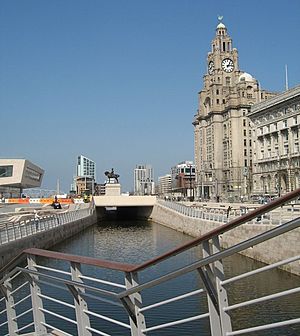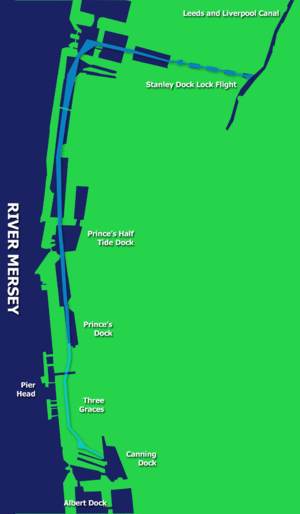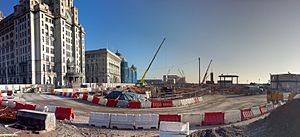Liverpool Canal Link facts for kids
The Liverpool Canal Link is a special waterway in England. It connects the Leeds and Liverpool Canal to the South Docks in Liverpool. This link cost about £22 million and opened in March 2009. It added 1.4 miles (2.25 km) of new water routes for boats to use.
Contents
History of the Canal Link
The original Leeds and Liverpool Canal was meant to connect directly to the docks in Liverpool. However, it took 30 years after the canal was finished for this to happen! In 1846, the canal finally linked to the docks through the Stanley Dock Branch.
Later, in the early 1900s, a dock called Georges Dock was filled in. This was done to build famous buildings like the Liver Building, Cunard Building, and the Mersey Docks and Harbour Board Building. These are now known as "the Three Graces." Because of this, the North and South Docks were no longer connected by water. Boats that wanted to travel between them had to go out into the River Mersey and then back in.
Planning the New Link
By the year 2000, people were working on many new canal projects across the country. The British Waterways Task Force, a group that looks after waterways, took over the South Docks area. They suggested linking the Leeds and Liverpool Canal to the South Docks again. This would involve building a new waterway right across the Pier Head.
In 2001, four possible routes were suggested. After asking the public for their ideas, one route was chosen. This winning route went right in front of the "Three Graces" buildings at the Pier Head. Money for planning came from different groups, and a detailed plan was ready by 2003. The project was expected to cost around £17 million.
There were some changes to the plans later on. This was partly because of a failed building project and some concerns from English Heritage, a group that protects historic places. A new plan was made by March 2005, which also included the new Museum of Liverpool. Permission to build was asked for in August 2005 and given in early 2006.
How the Route Works
The chosen route for the canal link includes several interesting features. It has two new locks, which are like water elevators for boats. There are also open channels, tunnels, and culverts (tunnels for water). Two new road bridges were built, along with structures to control water flow.
Parts of the docks between Salisbury Dock and Prince's Half-Tide Dock were filled in. A small drainage channel was left. Before this, this section was already watery and boats could use it. More digging was done at the northern end of the Trafalgar Dock area.
Between Trafalgar Dock and Prince's Half-Tide Dock, a 21-foot (6.4 m) wide channel was built. This went through Trafalgar Dock and the northern part of West Waterloo Dock. A new crossing was also made where Trafalgar and West Waterloo Docks meet. The channel from West Waterloo Dock to Prince's Dock was dug deeper, and the water level in the docks was lowered.
From the northern end of Prince's Dock to the Pier Head area, a new fixed bridge and a lock were built. The Prince's Dock Footbridge was raised so boats could pass underneath it. A new culvert was built under an area called Plot 7. Another culvert was built under St. Nicholas Place and the Liverpool Cruise Terminal, where big cruise ships arrive.
The last part of the canal link starts south of the Floating Roadway Basin. It crosses the Pier Head and ends at Canning Dock. About 500 meters (547 yd) of new canal was built here. This section also has new bridges and a lock. A new basin (a small harbor) was created at Mann Island, with lots of nice landscaping for people to enjoy.
Building the Link
In 2007, while the canal link was being built, workers dug up the sites of Chester Basin and Manchester Dock. During the digging, they found old carved stones in the Chester Basin area. These stones were identified as coming from the Liverpool Town Hall of 1673. This exciting discovery was even shown on a TV show called Time Team Special in April 2008.
The entire canal link was finished in December 2008. The section at the Pier Head was completed even earlier, in September. After some testing, the Liverpool Canal Link officially opened on March 25, 2009.
Images for kids














